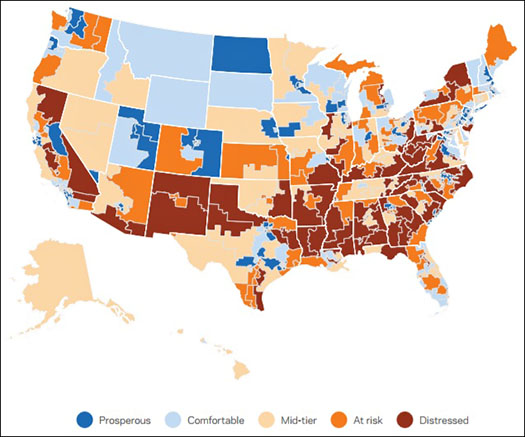
By Pam Martens and Russ Martens: September 26, 2017
A new study
backs up a theory that many Americans have long suspected: the U.S. is
no longer the land of opportunity, despite what national statistics
would have us believe. Rather, America is now narrowly constrained to
zip codes of opportunity.
The new research comes from the Economic Innovation Group (EIG), a bipartisan public policy organization funded by successful tech entrepreneurs.
The study provides detailed data on the economically distressed
communities that have fundamentally changed the economic landscape of
America. The authors write:
“A remarkably small proportion of places
fuel national increases in jobs and businesses in today’s economy. High
growth in these local economic powerhouses buoys national numbers while
obscuring stagnant or declining economic activity in other parts of the
country. EIG’s prior work shows that this trend represents a fundamental
shift in the geography of economic growth in the United States.
Geographic disparities have, of course, always existed in this country,
but the prospects of different communities used to rise or fall together
to a far greater extent than they do today. Now, national statistics
are often far removed from the experience of the typical American
community.”
Some of the key findings from the groundbreaking study are the following:
- 53 million individuals (one in six Americans) live in economically distressed zip codes;
- Prosperous zip codes are home to 84.8 million people, more than any other of the five tiers of communities;
- More than half of the country’s population living in distressed zip codes resides in the South;
- A quarter of the distressed population is under 18 years of age, meaning roughly 13 million American children are growing up in communities likely to have deeply negative “neighborhood effects” on young people’s future earnings potential;
- In the average distressed zip code, more than a quarter of the population lives in poverty, and over 40 percent of prime-age adults are missing from the workforce;
- The prime years of the national economic recovery bypassed many of America’s most vulnerable places altogether. Far from achieving even anemic growth from 2011 to 2015, distressed communities instead experienced what amounts to a deep ongoing recession, with a 6.0 percent average decline in employment and a 6.3 percent average drop in business establishments;
- 58 percent of adults in distressed zip codes have no education beyond high school.
One of the most disturbing findings is that the so-called “economic
recovery” has been a cruel illusion to a large swath of the U.S. The
authors write: “Most distressed zip codes contain fewer jobs and places
of business today than they did in 2000.”
The new study builds on 2016 research
from EIG which looked at the uneven geographic rate of new business
formation following the financial crisis of 2008. The authors wrote in
last year’s report:
“The 1990s recovery was fueled by a net
increase of nearly 421,000 business establishments, a 6.7 percent
uptick. The 2000s recovery saw a similar increase of 400,500 business
establishments, or a 5.6 percent uptick. By contrast, over the first
five years of the 2010s recovery, the number of business establishments
in the United States increased by only 166,500, representing a meager
2.3 percent expansion. Had they increased at the 1990s rate, 496,000 new
business establishments would have opened between 2010 and 2014 —
329,000 more than actually appeared.
“The muted increase in new business
establishments at the national level was not due to a universal decline
in the rate of establishment openings (even though the rate is in
long-term decline). One-fifth of all U.S. counties actually saw faster
increases in business establishments from 2010 to 2014 than from 2002 to
2006. Rather, subdued national-level growth was the product of a
geographically uneven collapse in new business formation that set in
across wide swathes of the country but left other corners relatively
untouched.”
EIG is headquartered in Washington, D.C. and states as a mission
objective the goal of bringing “geographic inequality into the national
conversation, analyzing the impact of the decline in entrepreneurship
and economic dynamism, and exploring the future of the economy.” Wall Street On Parade
No comments:
Post a Comment